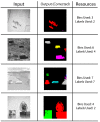A Linked List-Based Algorithm for Blob Detection on Embedded Vision-Based Sensors
- PMID: 27240382
- PMCID: PMC4934208
- DOI: 10.3390/s16060782
A Linked List-Based Algorithm for Blob Detection on Embedded Vision-Based Sensors
Abstract
Blob detection is a common task in vision-based applications. Most existing algorithms are aimed at execution on general purpose computers; while very few can be adapted to the computing restrictions present in embedded platforms. This paper focuses on the design of an algorithm capable of real-time blob detection that minimizes system memory consumption. The proposed algorithm detects objects in one image scan; it is based on a linked-list data structure tree used to label blobs depending on their shape and node information. An example application showing the results of a blob detection co-processor has been built on a low-powered field programmable gate array hardware as a step towards developing a smart video surveillance system. The detection method is intended for general purpose application. As such, several test cases focused on character recognition are also examined. The results obtained present a fair trade-off between accuracy and memory requirements; and prove the validity of the proposed approach for real-time implementation on resource-constrained computing platforms.
Keywords: embedded computer vision; field programmable gate array (FPGA); object detection.
Figures























References
-
- Malamas E.N., Petrakis E.G.M., Zervakis M., Petit L., Legat J. A survey on industrial vision systems, applications and tools, image and vision computing. Image Vis. Comput. 2003;21:171–188. doi: 10.1016/S0262-8856(02)00152-X. - DOI
-
- Kastrinaki V., Zervakis M.E., Kalaitzakis K. A survey of video processing techniques for traffic applications. Image Vis. Comput. 2003;21:359–381. doi: 10.1016/S0262-8856(03)00004-0. - DOI
-
- Hu W., Tan T., Wang L., Maybank S. A survey on visual surveillance of object motion and behaviors. IEEE Trans. Syst. Man Cybern. 2004;34:334–352. doi: 10.1109/TSMCC.2004.829274. - DOI
-
- Kumar V., Todorov E. MuJoCo HAPTIX: A virtual reality system for hand manipulation; Proceedings of the 2015 IEEE-RAS 15th International Conference on Humanoid Robots (Humanoids); Seoul, Korea. 3–5 November 2015; pp. 657–663.
LinkOut - more resources
Full Text Sources
Other Literature Sources
Research Materials

